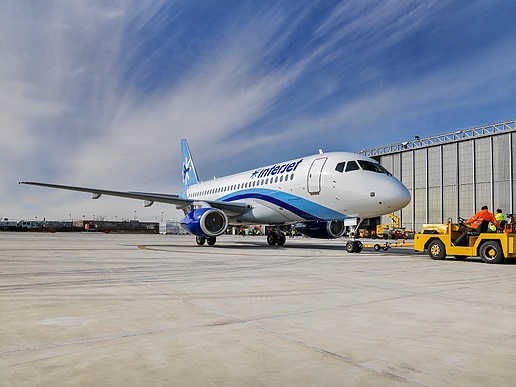 在数次推迟C系列的研发项目后,庞巴迪的CS300终于在2月底完成首飞。第一架升空的C系列机型为CS100,2013年9月完成首飞。
在数次推迟C系列的研发项目后,庞巴迪的CS300终于在2月底完成首飞。第一架升空的C系列机型为CS100,2013年9月完成首飞。 图为印有Atlasjet航空公司标志的庞巴迪CS300。
图为印有Atlasjet航空公司标志的庞巴迪CS300。 巴西航空工业次世代E-Jet升级款支线飞机,正在被设计开发成三个不的大小机型,首架E190-E2预计将于2018年交付,E195-E2将在2019,而E175-E2将于2020交付。
巴西航空工业次世代E-Jet升级款支线飞机,正在被设计开发成三个不的大小机型,首架E190-E2预计将于2018年交付,E195-E2将在2019,而E175-E2将于2020交付。 日本三菱MRJ90项目的持续延期,将导致它在这个非常有竞争前景的市场中丢失市场份额。
日本三菱MRJ90项目的持续延期,将导致它在这个非常有竞争前景的市场中丢失市场份额。 由合作伙伴Alenia生产的苏霍伊SSJ100已经开始在俄罗斯以外的地区限量销售。
由合作伙伴Alenia生产的苏霍伊SSJ100已经开始在俄罗斯以外的地区限量销售。
在被空客与波音垄断的150座以下级商用喷气式飞机市场中,下一代巨头将是加拿大庞巴迪和巴西航空工业公司。
庞巴迪曾在C系列喷气式飞机上雄心勃勃,但这段历史充满曲折。现在,庞巴迪计划靠CS300机型重回150以下座级喷气式飞机市场。该机型设计载客量为149人,但通常只配置130个乘客座位。比CS300稍小一些的CS100通常可载110名乘客,预计于今年年底之前由欧洲支线航空运营商瑞士航空启动运营。
庞巴迪计划在今年的巴黎航空展上向公众展示这两款机型,并期待借此重启停运多年的C系列机型生产线。目前,庞巴迪已接到多张尚未确认的订单,最新收到的订单中包括马来西亚Flymojo航空订购的40架飞机。庞巴迪希望很快便能宣布更多确认的订单。
庞巴迪正在对6架飞机进行测试,以取得适航认证。与波音737和空客A320窄体系列中最小的成员相比,C系列在中低密度级别航线上的性能更优秀,因为它不仅拥有更紧凑的机身,而且还使用了燃油效率较高的 P&W Pure Power齿轮传动式涡扇(GTF)发动机。
C系列最直接的竞争对手是巴西航空工业公司的下一代E-Jet机型。巴西航空工业公司为该系列设计了不同尺寸的机身,以配合该公司目前的直线飞机产品线的需要。新机型分别为E175-E2、E190-E2和E195-E2。第一批E190-E2预计将于2018年投产,E195-E2将在2019年投产,而E175-E2为2020年投产。目前为止,巴西航空工业公司已收到420架E2机型的已确认订单,或被列入客户采购的候选名单。E2发动机也是P&W的GTF,型号为PW1900G。
从设计伊始,三菱的MRJ90也打算选用燃油效率较高的P&W GTF发动机,以及高复合材料制成的轻型机身。然而由于规范的修订和由此引发的设计变更,项目只能延长交付期。这使得三菱失去了本来拥有的先机,现在则不得不与庞巴迪和巴西航空工业公司进行竞争,这两家公司的竞争机型无论在尺寸还是动力方面都与其旗鼓相当。三菱已收到200多份确认订单,而进入客户候选名单的订单数量也几近持平。
多年前,人们认为俄罗斯将凭借苏霍伊超级喷气式飞机抢占这一市场,该机型由俄罗斯与Alenia合作,在意大利进行生产。但随着西方对俄罗斯态度渐冷,并且超级喷气式飞机开始面临新的竞争,该机型在俄罗斯境外的销量变得极为有限(除墨西哥以外)。现在,俄罗斯正在中国建立一家全新的飞机租赁公司,该公司不仅将运营100架超级喷气式飞机,还将负责俄罗斯飞机在亚洲市场的推广。另外,在俄罗斯,Irkut正在研发一款全新的180座机型MC-21,但是除了在俄罗斯本土外,这款飞机也不太可能对波音和空客造成冲击。
在中国,针对国际市场的新商用飞机的自主研发仍处于早期阶段,但在国家大力支持航空业的背景下,中国的雄心依然不减。中国商飞的第一代机型ARJ21与MD-95的外形很相似,而且研发时间已超过12年。但是直到最近,该机型才获得中国的适航认证,预计将在今年下半年进入中国本土市场。
无论是波音还是空客,都已向中国的航空公司售出了1000多架飞机,目前,空客正在天津组装中国航空公司订购的A320。与此同时,中国正在生产自主研发的C919原型机,它是波音737和空客A320(150-180座)的直接竞争对手,采用CFM LEAP-1C发动机。尽管第一架C919飞机可能要到2015年底或2016年初才开始生产,上市时间预计为2018年左右,来自中国航空公司和飞机租赁公司的订单已经得到了450架。
与俄罗斯的MC-21相同,中国的C919也可能主攻本国航空公司,从而削减西方飞机制造企业在本国内的销量。但这两款机型在中长期内都不太可能对西方大腕造成影响。在未来几年内,他们无疑会积极主动持续地推行改进项目,在与新晋对手的竞争中保持不败之地。
Global contenders to break the commercial aircraft duopoly
In the commercial jet market below the 150-seat Airbus and Boeing killing fields, the next biggest sales are in the hands of Canada’s Bombardier and Brazil’sEmbraer.
Bombardier has had a troubled development history with its ambitious CSeries jetliners that nudge the sector edge with the CS300, which can seat up to 149 passengers but would usually be equipped with around 130 seats. The slightly smaller CS100, typically seating 110 passengers, is due to enter delayed airline service before the end of this year with European regional operator Swiss.
Bombardier is planning to show both versions in public for the first time at the Paris Air Show and hopes that this will re-launch the product line, which has been flatlining for a couple of years. The company has many unconfirmed commitments on its books, one of the latest being Malaysia’s Flymojo for 40 aircraft, and Bombardier will be hoping to announce more firm sales soon.
Flight tests using six aircraft are underway in the development program leading to certification. Compared to the smallest members of the Boeing 737 and Airbus A320 families, the CSeries offers more optimized performance on low-medium density sectors, with a lighter and more compact airframe and fuel-efficient P&WPure Power geared turbofan (GTF) engines.
The direct rival to the CSeries is to be found in Embraer’s next-generation E-Jet models. These are being developed in three different sizes, in line with the current Embraer regional jets. They will be known as the E175-E2, E190-E2, and the E195-E2. First deliveries of the E190-E2 are expected to be made in 2018, with the E195-E2 following in 2019 and the E175-E2 in 2020. So far 420 E2 models are on order and option. Power is being provided by P&Ws GTF again, designated the PW1900G.
From its outset, Mitsubishi’s MRJ90 was designed to also exploit the fuel-saving P&W GTF engines, as well as a lightweight airframe with high composite contents. However, extended delays due to revised specifications and subsequent design changes have resulted in the program losing its potential lead, and is now faced with well-established competition from Bombardier and Embraer, with similar size and similar powered rivals. Over 200 orders have been received, with a similar number of options.
A few years ago it was thought that Russia could be making inroads into this market sector with its Sukhoi Superjet, manufactured in cooperation with Alenia in Italy. But with Russia falling out of favor in the West and the Superjet facing new competition, sales beyond Russia have been very limited (except to Mexico) and now efforts are underway to establish a new leasing company in China, which might take 100 Superjets, and which might also assist sales campaigns in the Asian market. Also in Russia, Irkut is developing a new 180-seat airliner, the MC-21, but this is unlikely to have much, if any, sales impact on Boeing and Airbus sales, except perhaps in Russia itself.
China’s own attempts to develop new commercial aircraft aimed at the global market are still at an early stage though the ambition is still very strong, with massive subsidized state support for new aerospace factories. The initial program, the Comac ARJ21, is an MD-95 look-alike and has been in development for over 12 years. It only recently was awarded Chinese certification and is expected to enter domestic Chinese service later this year.
Both Boeing and Airbus have sold over 1000 aircraft each to Chinese airlines, and Airbus currently assembles A320s ordered for Chinese airlines at Tianjin, though China is currently manufacturing the first prototype of its own indigenous design, the C919. This is a direct rival to the 737 and A320 (150-180 seats) and will be powered by two CFM LEAP-1C engines. Chinese airlines and leasing companies have committed to 450 C919s to date, though the first flight may not take place until late 2015 or early 2016 and service entry is anticipated around 2018.
As with Russia’s MC-21, the Chinese C919 may reduce Western sales to the domestic airlines in these two countries, but they are hardly likely to create any medium-term concern for the big Western players who will no doubt be very active in the coming years through continuous improvement programs, to keep on top of any emerging competition.
等级
打分
- 2分
- 4分
- 6分
- 8分
- 10分
平均分
